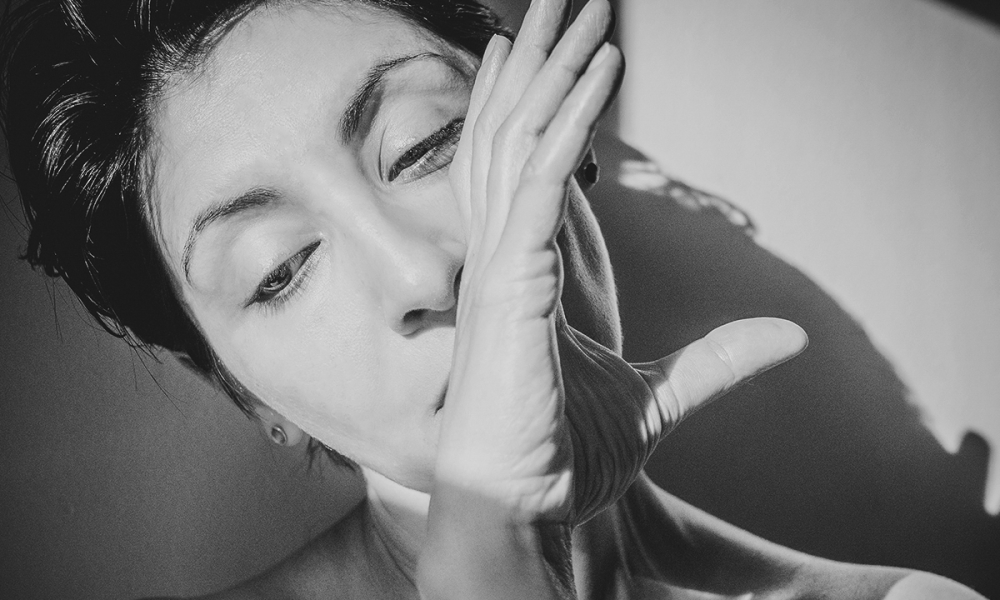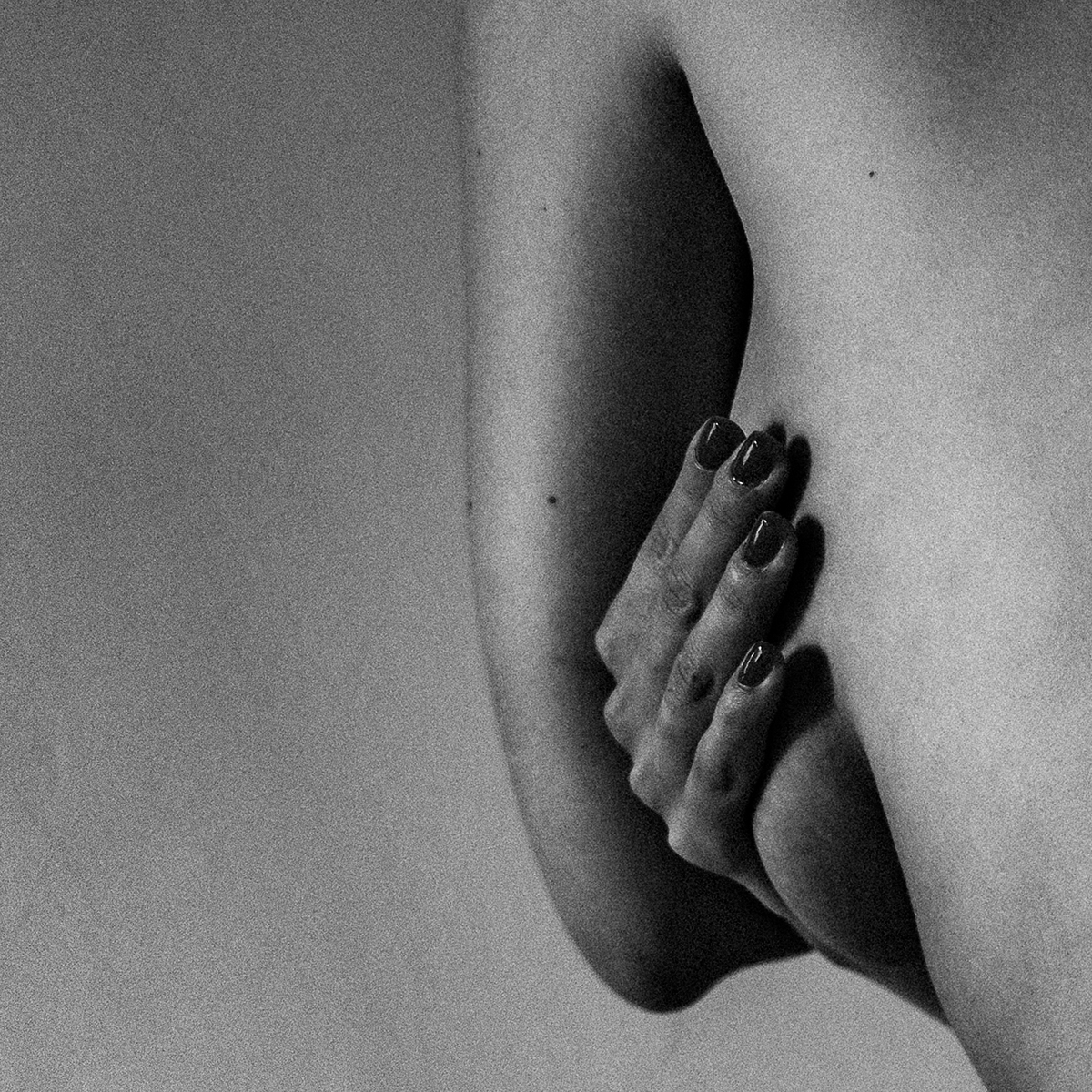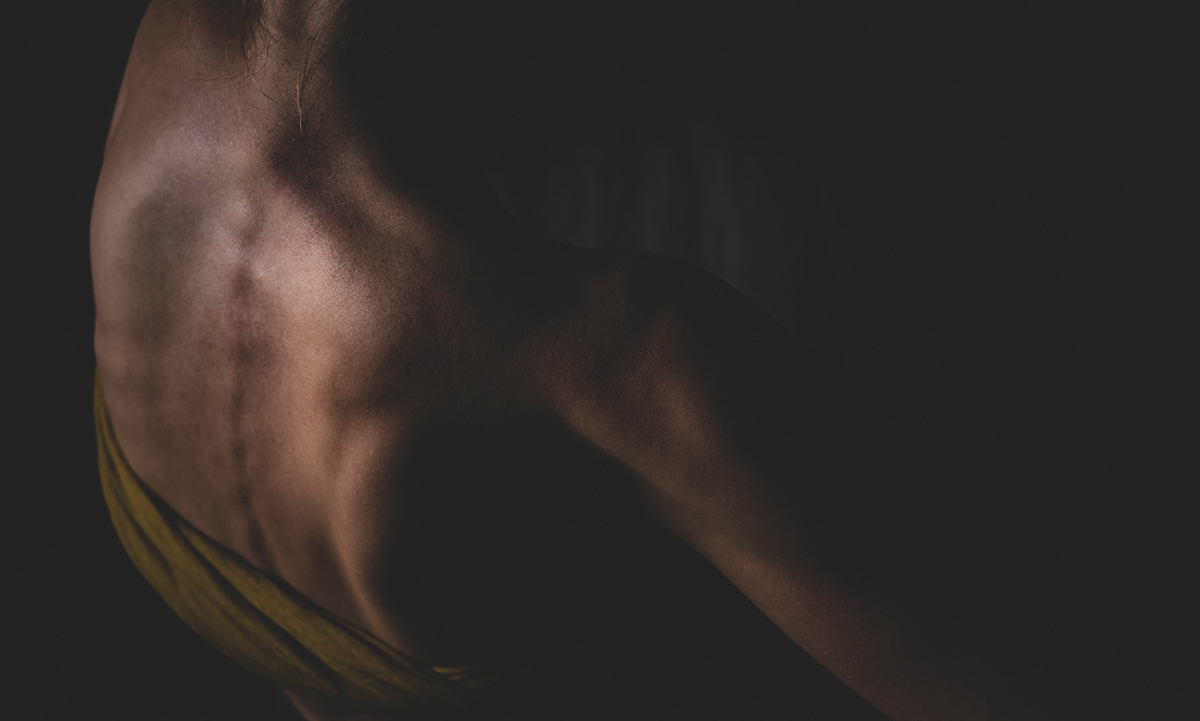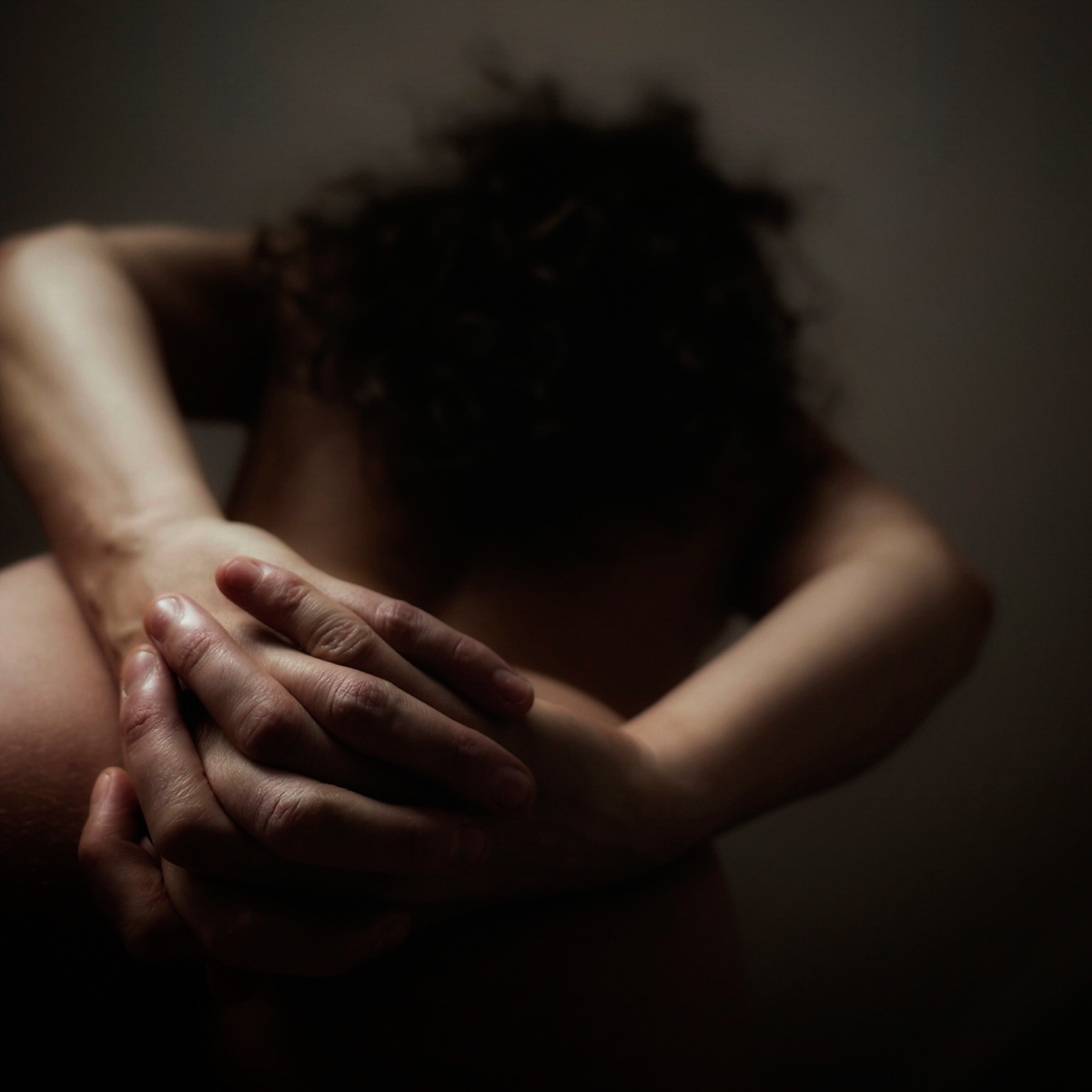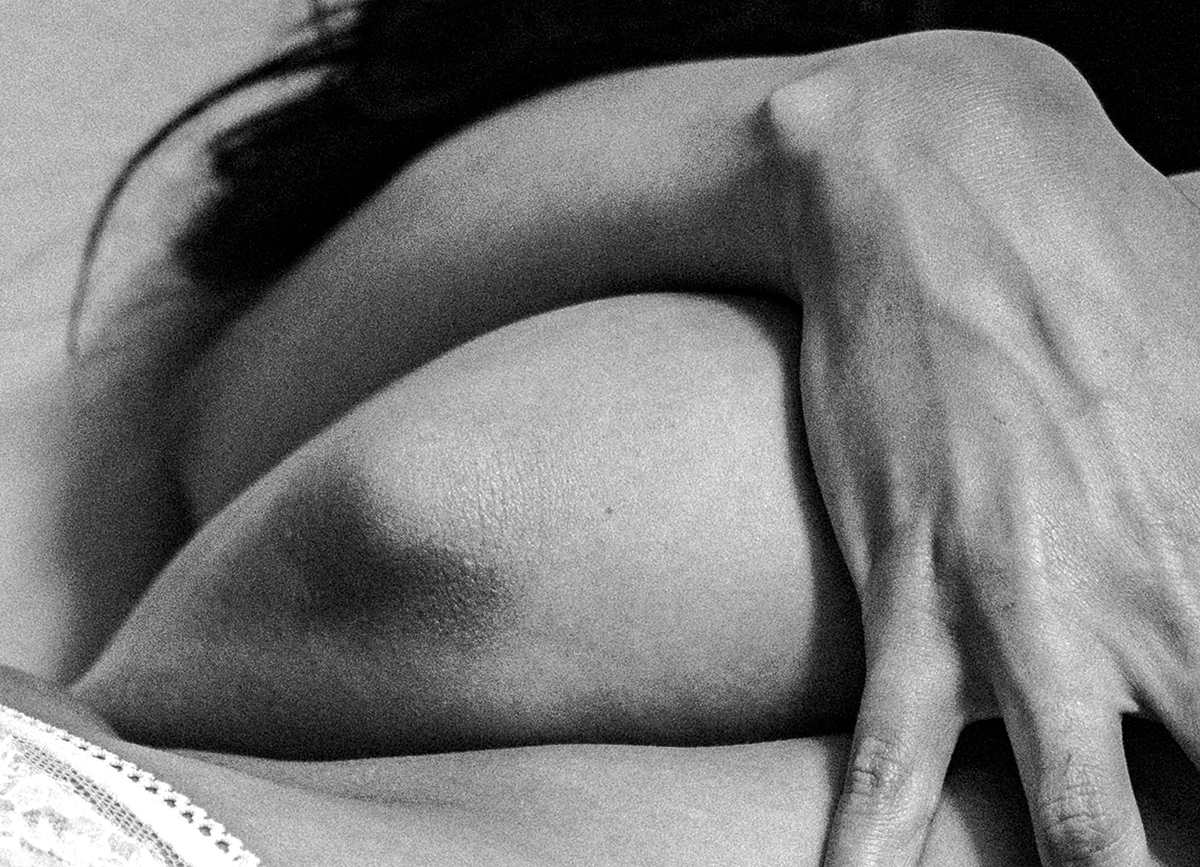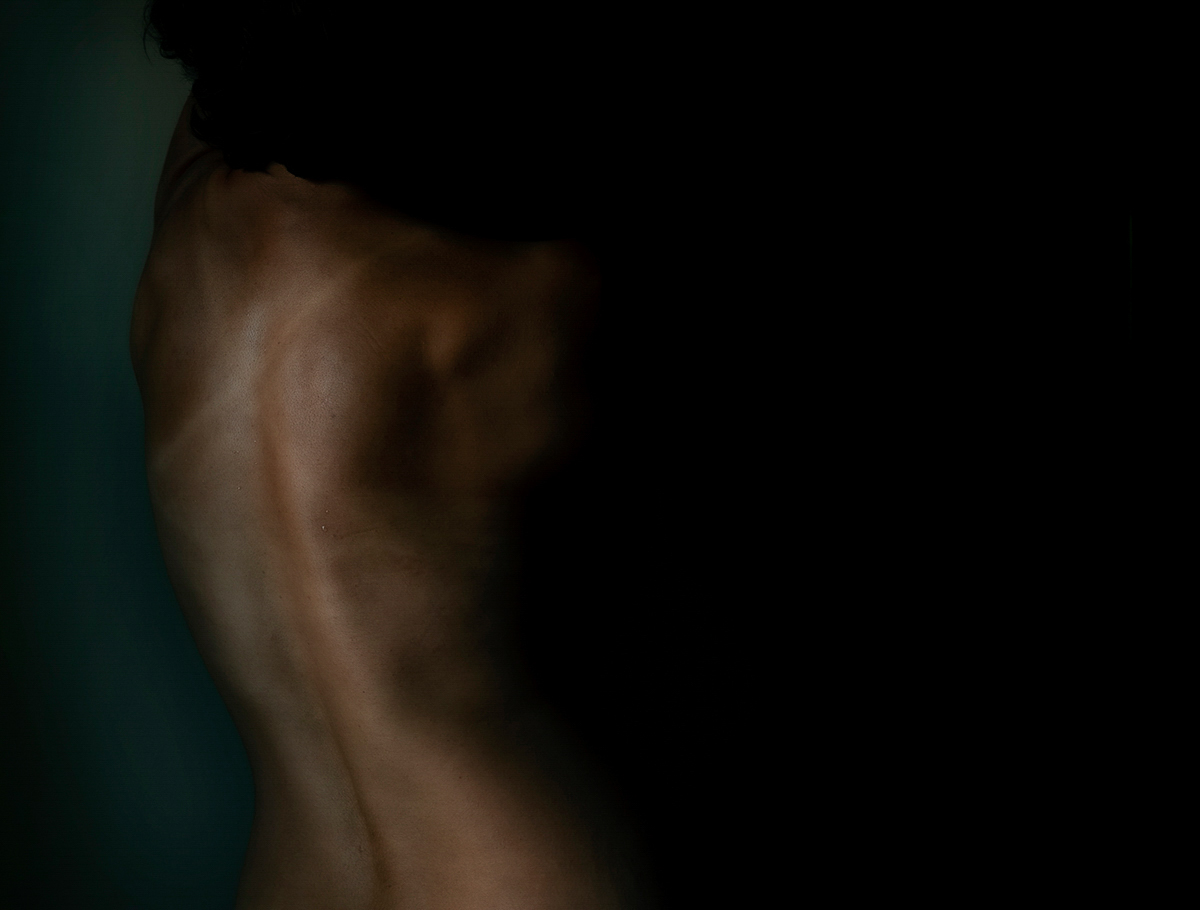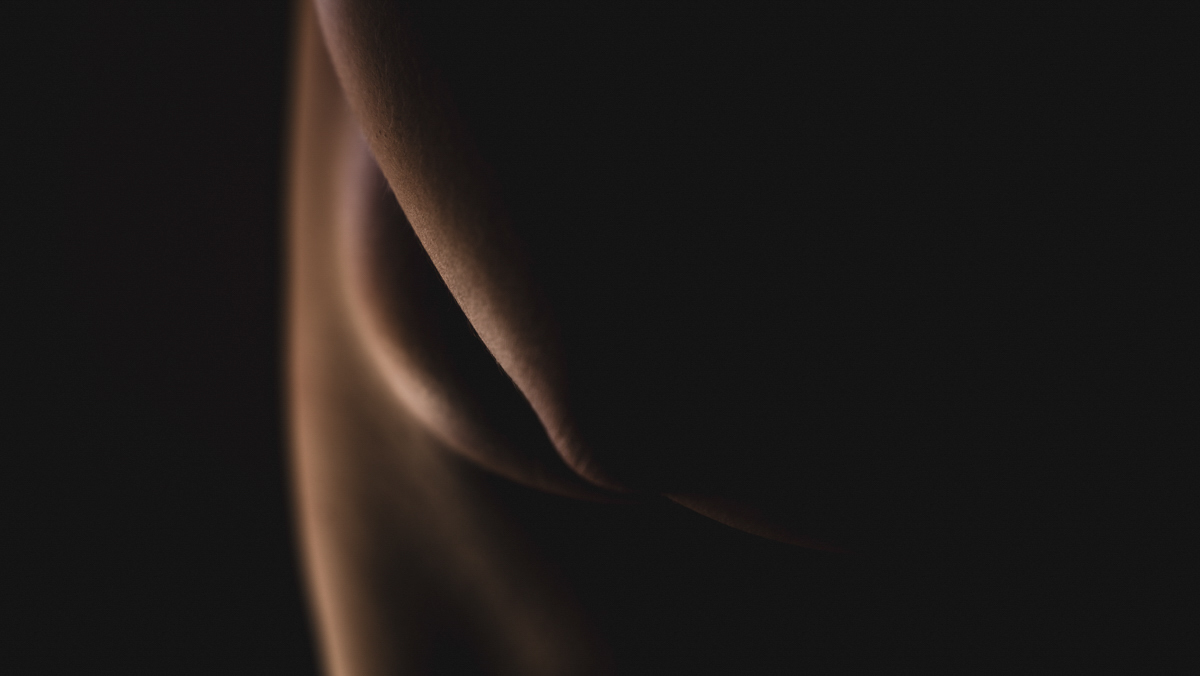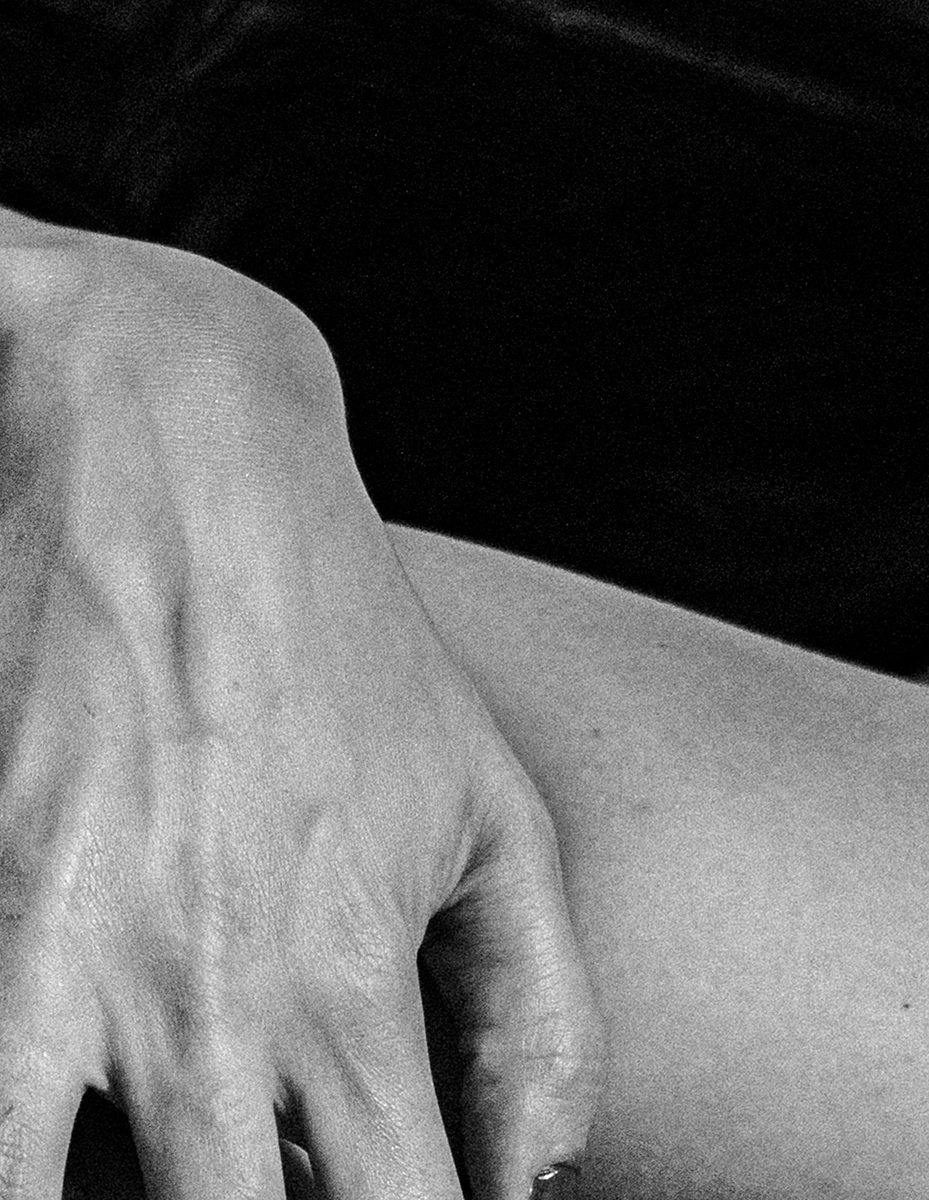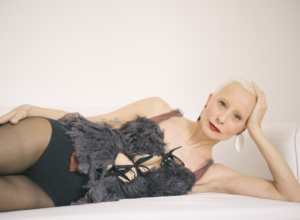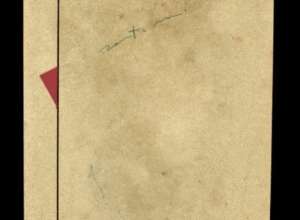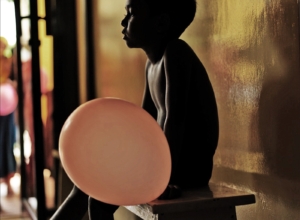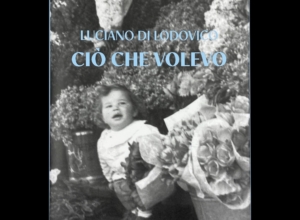Kristina Nazarevskaia è un’artista contemporanea che vive e lavora a New York. È nata in Armenia ed é cresciuta in Russia e in Etiopia. Avvalendosi di media diversi, Kristina indaga la comunicazione, la percezione spaziale e il comportamento, guardandoli attraverso gli occhi di un estraneo. Le sue fotografie sono un’amalgama di forme figurative e astratte spesso ispirate all’arte, alla letteratura, alla cinematografia e alla musica dell’epoca moderna e del dopoguerra. Oltre a insistere sul corpo, creando dei veri e propri paesaggi corporei, e a dedicarsi ai suoi progetti fotogiornalistici, Kristina lavora come fotografa in produzioni cinematografiche e televisive per Unit Stills e BTS.
Francesca Interlenghi: Vorrei partire dall’inizio e chiederti come sei arrivata alla fotografia? E che tipo di formazione hai avuto?
Kristina Nazarevskaia: La fotografia mi accompagna fin dall’infanzia. Mio zio, che all’epoca studiava cinema, è stata la prima persona a influenzarmi. Dovevo avere quattro o cinque anni quando una striscia di pellicola 16 mm che lui stava tagliando scivolò sul pavimento dove giocavo. La raccolsi e istintivamente la sollevai verso la luce. Vidi forme invertite, un nudo, avanzare lentamente fotogramma dopo fotogramma. A ripensarci adesso, dalla cattedra di una “storica dell’arte”, scherzo dicendo che era la mia versione del “Nudo che scende una scala” di Duchamp.
Più tardi avrei pregato mio padre di farmi delle foto. Non perché volessi essere fotografata (ancora adesso non mi piace stare davanti all’obiettivo della macchina fotografica), ma perché stamparle era l’esperienza più esaltante che potessi immaginare. Avevo sette anni. Tremavo per l’eccitazione quando la lampadina rossa si sostituiva a quella usuale, la luce si accendeva, venivano sistemati i vassoi, si disponeva la carta (facendo attenzione alle impronte digitali), si sistemava l’ingranditore e le pinze venivano disposte come strumenti chirurgici. Tutto accadeva nel bagno più piccolo di Yerevan. Restavo immobile, in attesa, ogni volta che le forme cominciavano ad apparire in quel liquido. E sì, conservo ancora oggi la maggior parte delle foto che abbiamo stampato in quel periodo. Perciò non era così sorprendente che fossi stata la prima della mia classe a prendere una macchina fotografica e scattare foto. Ma non erano niente di che …
Anni dopo ho iniziato il mio percorso all scuola di cinema della NYU e più tardi mi sono laureata in storia dell’arte. Ho imparato a dipingere, ho imparato guardando e comprendendo cosa mi piaceva e cosa no. Cosa e chi è venuto prima di me, cosa ha innescato l’innovazione tecnica e teorica, cosa è rimasto e cosa è svanito e perché. Cosa è già stato detto e cosa deve essere approfondito. Ho passato anni in studio creando lavori astratti, influenzata da Frankenthaler, Serra, Motherwell, Gorky, Albers. Questi dipinti sono presenti in molte collezioni private e pubbliche in tutto il mondo, molti sono apparsi nei principali film e serie TV di Hollywood. Ero a mio agio con la pittura ma non avrei mai potuto definirmi una fotografa. Il mio ex marito invece aveva occhio. Ricordo ancora i suoi straordinari lavori fotografici, racconti di viaggio in bianco e nero. Li guardavo e sapevo visceralmente che mentre le sue immagini cantavano, danzavano e ti trascinavano dentro, le mie erano statiche e piatte. Tutto è cambiato due anni e mezzo fa. Quindi, vedi, sono davvero una principiante per quanto riguarda la fotografia.
Francesca: Come ritieni si sia evoluta la tua pratica artistica negli anni?
Kristina: Ora conosco gli elementi costitutivi di base delle immagini. Vedo l’immagine. So istintivamente cosa del telaio deve restare e cosa deve essere eliminato. A volte la storia è nei minimi dettagli. È lì, deve solo essere identificata. Inoltre non ho paura di fotografare le persone. All’inizio direi che ho scattato foto di cose che non parlavano. Ora voglio che mi parlino! Voglio che interagiscano con me! Ora posso fotografare chiunque, ovunque, in qualsiasi momento, in ogni caso. Riesco a leggere istintivamente la persona e il luogo e creare l’immagine.
Inoltre, continuo a sperimentare, indagando ogni aspetto del medium. Ho questa consapevolezza dentro di me. Dopo migliaia di ore trascorse ad assorbire il linguaggio di Eco, Lagerkvist, Auster, Saramago, Calvino, Cortazar, Dostoyevsky, Bulgakov, ecc., a sentire in profondità le parole, a studiare storia dell’arte, a comprendere la filosofia e la teoria, il significato dei colori, la loro collocazione, sono in grado di fare riferimenti visivi significativi, a mio piacimento, e so quando lasciare che un’immagine sia, perché non sono ancora arrivata al punto in cui posso vederla. La pittura mi ha insegnato questa particolare pazienza.
Francesca: Come descriveresti il tuo approccio alla fotografia e la tua attitudine?
Kristina: Prima guardo e ascolto. Osservo il movimento delle persone, la loro plasticità, il modo in cui esprimono le emozioni, la loro mimica, i movimenti, se sono disinvolti, e la loro fluidità. Guardo, per capire come nascondono le loro paure. Cosa gli fa abbassare la guardia ed espirare. Come mi rispondono e quanto posso avvicinarmi senza invadere il loro spazio personale. Cosa succede se? Quando lo faccio? Stanno posando? Odio quando le persone posano. Non mi interessa una persona generica, io voglio veder te. E se sento che la persona si fida di me, allora propongo una sessione, consapevole che il giorno in cui ci incontreremo l’energia potrebbe non essere la stessa. Ho avuto giorni in cui l’energia creativa non c’era e tutto s’è risolto con un nulla di fatto. Ho guardato e non ho visto niente. Succede. Preferisco riconoscere questo e lasciare che sia, piuttosto che fare forzature. Forzare qualcosa che non vuole accadere non produce mai nulla di buono. Se è destinato a funzionare, lo farà!
Il giorno in cui devo scattare le foto spesso lascio che il soggetto si muova, parli, senta lo spazio finché non colgo la luce (scatto principalmente con la luce naturale) e poi dico: “Non muoverti!”. Parole che rapidamente si trasformano in un suono “aa-a”. Chiedi a chiunque abbia lavorato con me e ti dirà che gli basta un’ora per capire i miei segnali non verbali. Ciò accade soprattutto perché è importante per me mostrare loro ciò che sto fotografando, quello che vedo quando dico loro di stare immobili in una strana posizione. Vedono quello che vedo io e quando vedono la mia testa scuotersi, o il mio mento muoversi, o il mio dito alzarsi, mantengono la posa esattamente come voglio e sanno esattamente perché il dito, la spalla, il collo devono rimanere lì e non 2 cm più in basso o in alto.
Una nota tecnica, che mi rende anomala rispetto ai miei colleghi. Non scatto mai attraverso l’obiettivo della macchina fotografica, bensì sempre attraverso lo schermo dietro. Tocco la messa a fuoco sullo schermo e scatto. Il più delle volte scatto in bianco e nero, passando al colore solo per controllarne la temperatura. Scatto in RAW e jpeg in modo da poter visualizzare in anteprima tutti i file ed eliminare ciò che non voglio. Ho lavorato con Nikon negli ultimi 20 anni, ma sono passato a una Panasonic GH5 e, nonostante tutti i suoi limiti, la amo. È stata lo strumento che mi ha aiutato a raggiungere questo livello e la porto con me ovunque. Recentemente ho acquistato una Leica SL2. Spesso dico che è come aver guidato negli ultimi 20 anni una Toyota affidabile e solo per un giorno poter avere le chiavi di una Bugatti. La Leica è avanti anni luce rispetto a qualsiasi altro prodotto sul mercato oggi.
Francesca: Chi ti ha influenzato di più?
Kristina: Qualcuno che non posso nominare. Lui sa chi è. Ricordo ancora il momento in cui l’ultimo pezzo del puzzle è andato al suo posto, quando lui mi ha mostrato come concentrarmi su ciò che conta. A lui ho dedicato il mio primo libro fotografico.
Richard Serra ha un’enorme influenza su di me e sul modo in cui percepisco il movimento e lo spazio. Lo stesso vale per Tony Smith. Ho interi corpi di lavoro che traggono ispirazione dalle loro sculture. Roger Deakins, Andrei Tarkovsky, Pawel Pawlikowsky, Louis Malle, hanno lasciato i segni più profondi.
Per quanto riguarda gli altri fotografi, direi Mona Kuhn, Richard Misrach, Sam Livm, gli incredibili scatti panoramici di Jeff Bridges, Adam Fuss, Alison Rossiter. Adoro poi i fotogrammi del ghiaccio che si scioglie di Farrah Karapetian, Margrethe Mather, le fotografie di O’Keeffe, Berenice Abbott, Leon Levinstein, Helen Levitt, Gordon Parks, Laszlo Moholy-Nagy, Weston, i fotografi di strada di New York degli anni ’60, ’70 e ’80. Ci sono alcuni fotografi giapponesi contemporanei che amo. Da sei anni lavoro anche con e per AIPAD, l’Associazione dei commercianti di fotografia d’arte internazionale, quindi mi nutro costantemente di immagini.
Francesca: Nel tempo hai sviluppato un vocabolario visivo ben definito che si concentra sui volti, i corpi, i gesti e le posture. Il tuo sguardo restituisce significative rappresentazioni del corpo femminile. E’ qualcosa a cui hai pensato fin dall’inizio?
Kristina: Tutt’altro. Avevo il terrore di fotografare le persone. Il mio primo tentativo di superare questa paura paralizzante è stato a Istanbul nel 2003. Ho vagato per le strade polverose, con la mia Nikon F3, evitando l’effetto patinato di negozi e turisti, scattando foto alla gente del posto. I bambini erano i miei preferiti. Candidi, onesti, diretti, naturali, senza pose. Quelli sono stati i miei primi ritratti.
La mia prima sessione fotografica incentrata esclusivamente su una forma femminile l’ho realizzata un anno fa con un’amica, un essere umano gentile, che ha riposto in me straordinaria fiducia e che stava attraversando un momento di trasformazione personale. Un mese dopo ho invitato un’ altra amica per una sessione e anche lei ha aperto nuove porte alla mia creatività. Abbiamo scattato per ore in uno spazio minuscolo della mia cucina dove la luce è sempre straordinaria.
Un’altra sessione improvvisata in Messico e poi sono finita in quarantena. Per mantenere la mia mente lucida, ho deciso di continuare a scattare foto. È stata, in un certo senso, una prova per quando avrei potuto fotografare di nuovo gli altri.
Devo dire che ogni sessione è una storia a sé. Non so mai cosa accadrà con quella persona o come. Lascio che accada anche perché non esistono due persone che abbiano portato la stessa energia in uno scatto. Anche quando ho fotografato qualcuno per la seconda volta, l’esperienza è stata sempre diversa. Inoltre, fotografo raramente il volto di qualcuno. In parte a causa della mia preoccupazione per la privacy, online e offline. So bene che il progresso tecnologico permette di identificare le persone nel mondo virtuale dato che le informazioni non scompaiono mai, quindi concedo l’anonimato ai miei modelli. Parlando da un punto di vista concettuale, il nostro viso e i nostri occhi richiedono che ci concentriamo su di loro. Siamo portati a farlo senza pensarci. Ma io non voglio che lo spettatore si concentri sull’atteso. Voglio che impari a vedere come e cosa vedo io.
Francesca: Guardo le tue immagini e mi sembrano una sorta di contemplazione sull’intimità perduta, sempre in equilibrio tra toni drammatici e glamour sofisticato. Puoi dirmi di più in merito al tuo processo creativo?
Kristina: “Una contemplazione sull’ intimità perduta”. Non me lo ha mai detto nessuno prima, ma è vero al 100%. Dovrò ragionarci … ma sì, è vero. C’è un profondo senso di malinconia nel mio lavoro. Qualcosa di genetico, forse? Gli armeni dicono spesso che il dolore e la sofferenza dei loro antenati restano impressi per sempre nelle generazioni future. Che ogni armeno porta una tristezza più profonda nella propria anima.
Per quanto riguarda le foto, sposto intenzionalmente e molto consapevolmente la mia prospettiva per guardare il corpo come se fosse una scultura (anche se non mi innamoro delle mie Galatee – nella mitologia greca, Galatea era una delle cinquanta ninfe del mare ndr). Disegno e modello l’immagine astraendo da ciò che è familiare e costringendo al riesame di ogni elemento noto. Non mi interessa sessualizzare il corpo. Non vedo un corpo senza vestiti ma vedo un corpo nudo e questa è una distinzione importante. Basta chiedere a tutti quei “critici” che hanno schiumato di indignazione per l’Olimpia di Manet. Il mio lavoro riconosce la sensualità e la bellezza della figura umana, ma il mio interesse è per la geometri. Mi interessa individuare e amplificare le tensioni della superficie, attirare l’attenzione sulla consistenza, la densità dei neri e bianchi, sulle forme e manipolarne la percezione. Tutte le cose che facevo con la pittura ora le sto facendo con la macchina fotografica.
Francesca: Stai lavorando a qualche nuovo progetto?
Kristina: Ho pubblicato due libri fotografici la scorsa estate. Il primo è una raccolta di nature morte scattate durante la quarantena a New York. Si intitola Soliloquies, una parola che mi sembrava appropriata per definire l’esperienza di trascorrere interminabili settimane di isolamento, in solitudine. Il libro è dedicato a mio padre, morto alla fine di aprile.
Il secondo libro si intitola Private ed è la prima raccolta dei miei paesaggi corporei, così come mi piace definirli. Il libro è una lettera d’amore. Tiene insieme ritratti, autoritratti e immagini della natura. Ogni combinazione racconta una storia diversa. Alcune sono timide, altre mormorano, altre martellano e urlano, altre fluiscono e ti portano con sé … La mia speranza è che queste immagini continuino a evolversi da sole. Tra 5, 10, 20 anni voglio che raccontino nuove storie, indipendentemente da me.
Dopo che è uscito il primo volume di Private, ho lavorato al secondo: ad oggi sono 170 pagine. Ho appena terminato una sessione fotografica con una coppia e ne ho altre tre in arrivo con persone che ho incontrato su Instagram e in un negozio a New York. Se non sto attenta, finiranno per essere 300 pagine! Penso che lo intitolerò “Stai ferma”.
Kristina Nazarevskaia, web site – Instagram
Tutte le immagini ©Kristina Nazarevskaia. Nessun uso o riproduzione è permessa senza l’autorizzazione scritta dell’artista
________________________________________
ENGLISH TEXT
Kristina Nazarevskaia is a NYC-based contemporary artist. She was born in Armenia and raised in Russia and Ethiopia. Through various series, scales, and media, Kristina examines communication, spacial perception, and behavior, seen through the eyes of an outsider. Kristina’s photographs are an amalgamation of figurative and abstract forms, often inspired by Modern and Post War art, literature, cinematography, and sound. In addition to her corporal landscape and photo journalistic projects Kristina works as a Unit Stills and BTS photographer on film and TV productions.
Francesca Interlenghi: I’d like to start at the beginning. How did you come to photography? And what training did you have?
Kristina Nazarevskaia: Photography surrounded me since childhood. My uncle, a film student at the time, was my earliest influence. I must’ve been four or five when a strip of 16mm film he was cutting snaked down on the floor where I was playing. I picked it up and instinctively held it up to the light. I saw inverted shapes, a nude, slowly progress from frame to frame. Thinking about it now from the “pedestal” of an Art Historian, I joke that it was my very own expansion of Duchamp’s “Nude Descending a Staircase”.
Later I would beg my father to take pictures. Not because I wanted to be photographed (I still dislike being in front of the camera), but because printing them was the most exhilarating experience I could imagine. I was 7. I trembled with excitement as the red bulb replaced the usual one, the light came on, trays were arranged, paper laid out (mind the fingerprints), the enlarger set up, and tongs arranged like surgical instruments. All in the smallest bathroom in Yerevan. I froze in anticipation each time shapes began to appear in that liquid. And yes, I still have most of the photos we printed. So, it wasn’t so surprising that I was the first in my class to get a camera and take photos. They weren’t any good…
Years later I negotiated my way into NYU film school and later got a degree in art history. I taught myself to paint learning by looking and understanding what I liked and what I didn’t. What and who came before me, what triggered innovation, technical and theoretical, what stayed and what faded away and why. What has already been said and what needs to be explored further. I spent years in the studio creating large-scale abstract work influenced by Frankenthaler, Serra, Motherwell, Gorky, Albers. These paintings are in many private and corporate collections around the world. Many were featured in major Hollywood films and TV series. Yet, as confident as I was a painter, I never could call myself a photographer. My ex-husband had an eye. I still remember his extraordinary black and white travel photo essays. I would look at them and viscerally know that while his images sang and danced and pulled you in, mine were static and flat. All that changed 2.5 years ago. So, you see, I’m really a novice in this medium.
Francesca: How do you feel your practice has evolved during the years?
Kristina: I now know the basic building blocks of images. I see the frame. I know instinctively what needs to stay, what must be eliminated to allow the frame its own life. Sometimes the story is in the smallest detail. It’s there, it just needs to be identified. I am also not afraid to photograph people. Before, I would say that I took pictures of things that didn’t talk back. Now I want them to talk back! I want them to engage with me! What’s evolved is now I can photograph anyone, anywhere, anytime, anyhow. I can read the person and the location instinctively and make the image.
Plus, I am always experimenting. With every aspect of the medium. I have this internal confidence. After thousands of hours spent absorbing language (Eco, Lagerkvist, Auster, Saramago, Calvino, Cortazar, Dostoyevsky, Bulgakov, etc.), being able to feel the resonance of words, studying art history, understanding philosophy and theory, meaning of colors, their placement, being able to make meaningful visual references at will and knowing when to let an image be, because I am not yet at the level where I can see it. Painting taught me this particular patience.
Francesca: How would you describe your approach and attitudes?
Kristina: I watch and listen first. I watch for people’s movement, their plasticity, how they express emotions, their mimicry, freedom of movement, fluidity. I watch to see how they hide their fears. What makes them release their guard and exhale. How they respond to me and how close can I get and not invade their personal space. What happens if/when I do? Are they posing? I hate when people “pose”. I am not interested in a persona. I want to see you. And if I feel that the person trusts me then I will suggest a session. And even on the day of the shoot the energy may change. I’ve had days when creative energy just wasn’t there and we shot nothing. I looked and saw nothing. And that’s fine. I’d rather recognize this and let it be than force the shoot. Forcing something that doesn’t want to happen never produces anything good. If it’s meant to work – it will!
On the day of the shoot, I often let the person move, talk, feel the space until I catch the light (I shoot primarily with natural light) and then it’s: “Don’t move!” which rapidly devolves into an “aa-a” sound. Ask anyone I’ve shot with and they will tell you that within the first hour they learn my non-verbal cues. This happens largely because it’s important for me to show them what I’m photographing. What I see when I tell them to freeze in some strange position. They see what I see, and next time they see my head shake, or my chin move, or my finger go up, they hold the pose exactly as I want and know exactly why the finger, the shoulder, the neck has to stay there and not 2 cm down or up.
On a technical note, I am the outlier among my peers. I never shoot through the viewfinder – it’s always the back screen. I touch focus on the screen and shoot. More often than not, I shoot in black and white, switching to color just to check color temperature. I shoot in RAW and jpeg so I can preview all files and delete what I don’t want. I’ve had Nikons for the last 20+ years but made the switch to a Panasonic GH5 and for all its limitations, I love my baby. She was the tool that helped me reach this stage and I tend to carry her with me everywhere. Recently I got a Leica SL2. I often compare the experience to having driven a reliable Toyota for the last 20 years, only to, one day, be given the keys to a Bugatti. The Leica is lightyears ahead of anything else on the market today.
Francesca: Who influenced you the most?
Kristina: Someone, whom I can’t name. He knows who he is. I still remember the moment when the last piece of the puzzle was put into place and he quite literally showed me how to focus on what matters. I dedicated my first book of photographs to him.
Richard Serra is a huge influence on how I perceive movement and space. Same goes for Tony Smith. I have whole bodies of work informed by their sculptures. Roger Deakins, Andrei Tarkovsky, Pawel Pawlikowsky, Louis Malle, made the deepest imprints.
As far as other photographers go, I’d say Mona Kuhn, Richard Misrach, Sam Livm, Jeff Bridges’ incredible panoramic set stills, Adam Fuss, Alison Rossiter, I love Farrah Karapetian’s melting ice photograms, Margrethe Mather, O’Keeffe’s photographs, Berenice Abbott, Leon Levinstein, Helen Levitt, Gordon Parks, Laszlo Moholy-Nagy, Weston, the New York street photographers from the 60’s, 70’s, and 80’s,. There are some contemporary Japanese photographers I love. I also worked with and for AIPAD, the Association of International Photography Art Dealers for 6 years now, so I’m constantly looking at images.
Francesca: You have developed a distinct visual vocabulary that focuses on faces, bodies, gestures and postures. You offer significant examples of representations of the female body. Did that articulate itself from the beginning?
Kristina: Far from it. I was terrified of photographing people. My first attempt at overcoming this paralyzing fear was in Istanbul in 2003. I wandered the dusty back streets, with my Nikon F3, shielded from the gloss of shops and tourists, and took pictures of local people. Kids were my favorite subjects. Candid, honest, direct, unposed, natural, theirs were my first portraits.
My first photo session that focused exclusively on a female form was a year ago with a friend, a kind and an extraordinarily trusting human being, who was going through a personal transformation. A month later I invited another friend for a session and that too opened new creative doors. We shot for hours in a tiny space in my kitchen where light is always extraordinary.
One more impromptu session in Mexico and I landed into quarantine. To keep myself sane I decided to just keep taking pictures. It was, in a way, a rehearsal for when I’d be able to photograph others again.
I have to say that each session creates its own path. I never know what I will shoot with that person or how. I just let it happen and I usually take it from there. No two people have brought the same energy to a shoot. Even when I photographed someone for the second time, the experience was always different. Also, I rarely photograph someone’s face. Partially because of my concerns for privacy, online and off. I am very aware of all kinds of technological advances that can identify people in the virtual world and that that information never disappears. I choose to allow my models anonymity. Speaking from a conceptual POV, our face, our eyes demand that we focus on them. We are conditioned to do so without thinking. I want to pull you away from focusing on the expected. I want you to learn to see how and what I see.
Francesca: Your images sound like meditation on lost intimacy. They are delicately balanced by dark drama and sophisticated glamour. Can you tell me more about your process of working?
Kristina: “A meditation on lost intimacy.” I’ve not heard this before, but it is 100% true. I will have to contemplate that … but, yes, it’s true. There is a deep sense of melancholy in my work. Something genetic, perhaps? Armenians often say that their ancestors’ sorrow and suffering were permanently imprinted on future generations. That every Armenian carries a deeper sadness in their soul.
As far as the actual frame goes, I intentionally and very consciously shift my perspective to see the body as if it were a sculpture. (Albeit I don’t fall in love with my Galateas). I draw and shape the frame with their forms to abstract the familiar and force a re-examination of every element you think you know. I am not interested in sexualizing the body. I am not looking at it as “naked”, but as “nude” and that’s an important distinction. Just ask all those “critics” who frothed with indignity at Manet’s Olympia. My work recognizes the sensuality and the beauty of the human form but my interest instead lies in geometry, finding and amplifying surface tensions, drawing attention to texture, density of blacks and whites, shapes, and manipulating perception. All the things I used to do in my painting I am now doing with my camera.
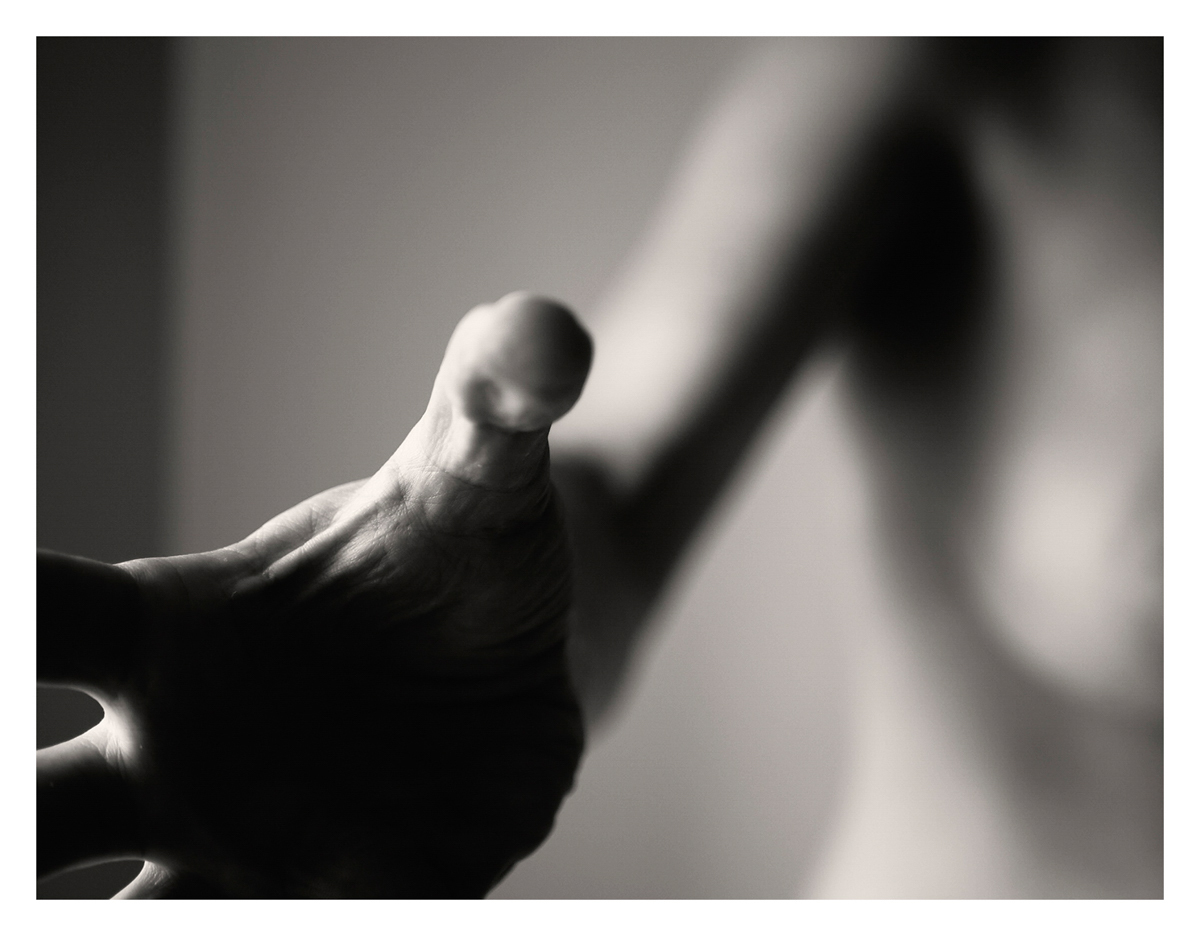 Francesca: Do you have any upcoming projects?
Francesca: Do you have any upcoming projects?
Kristina: I published two books of photographs this summer. The first is a collection of still lives taken during quarantine in NYC, titled Soliloquies – a word that seemed most appropriate for the experience of spending endless weeks of lockdown in solitude. The book is dedicated to my father who died at the end of April.
The second book is titled Private and that’s the first tome of my corporal landscapes, as I refer to them. The book is a love letter. It combines portraits, self-portraits and images of nature. Each combination tells a different story. Some are shy, some hum, others pound and scream, some flow and take you with them… My hope for these images is to continue evolving on their own. 5, 10, 20 years from now I want them to be telling new stories independently of me.
Ever since the first Private book came out, I’ve been working on volume II. So far, it’s 170 pages and counting. I just wrapped a session with a couple and have three more shoots coming up with people I met on Instagram and one in a store in NY. If I’m not careful, it’s going to end up being 300 pages! I think I’ll call it “Stai ferma”.
Kristina Nazarevskaia, web site – Instagram
All images ©Kristina Nazarevskaia. No use or reproduction allowed without artist’s written permission.


